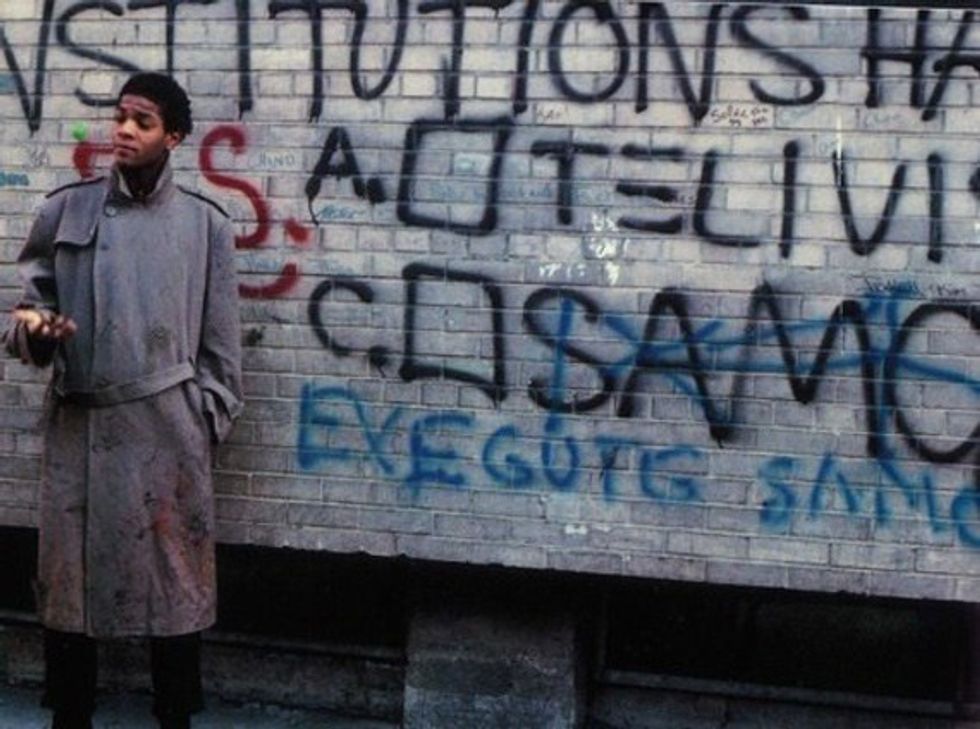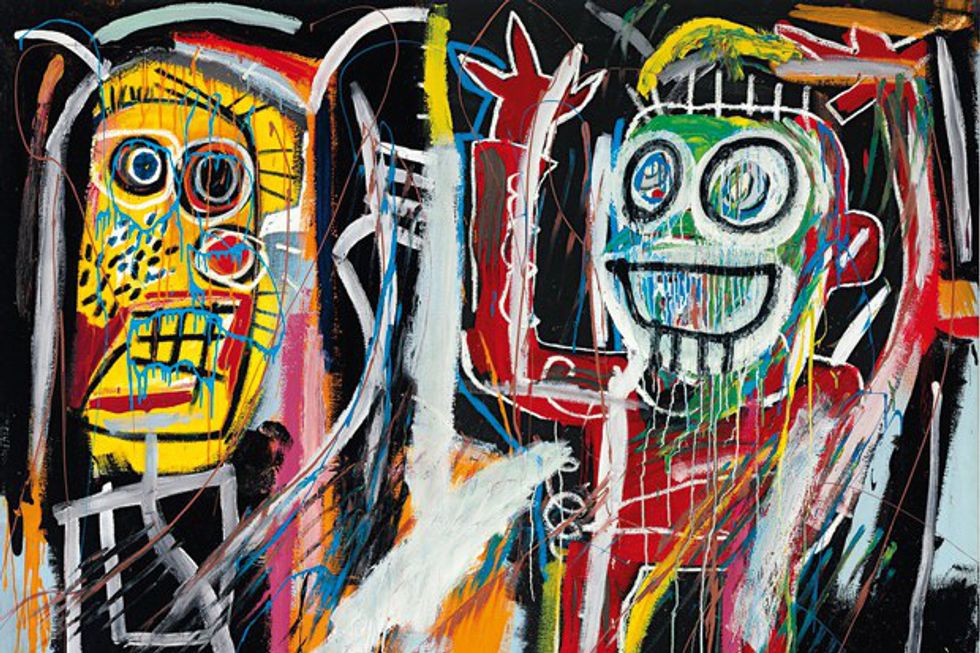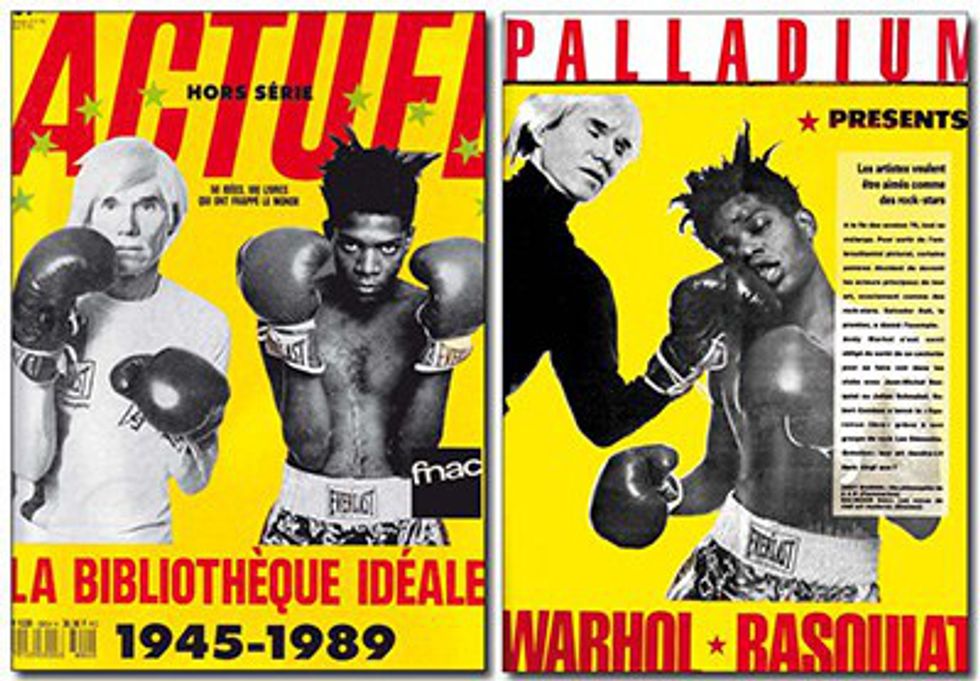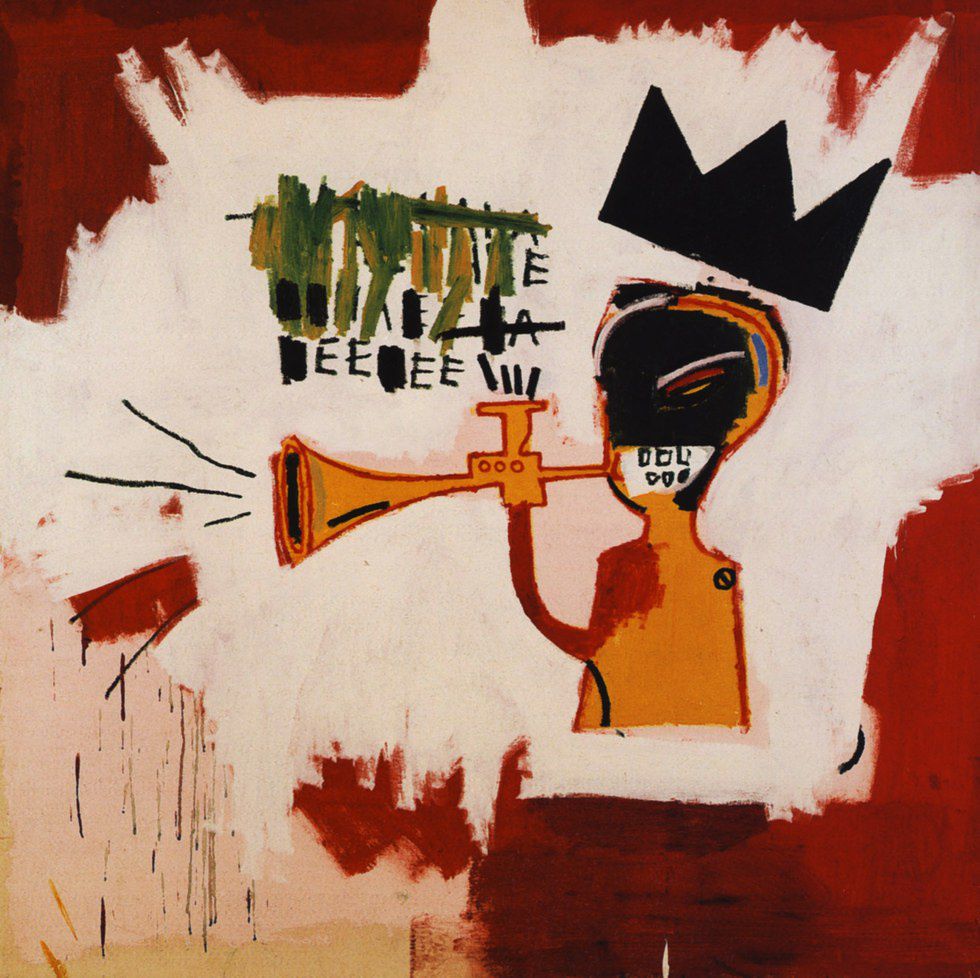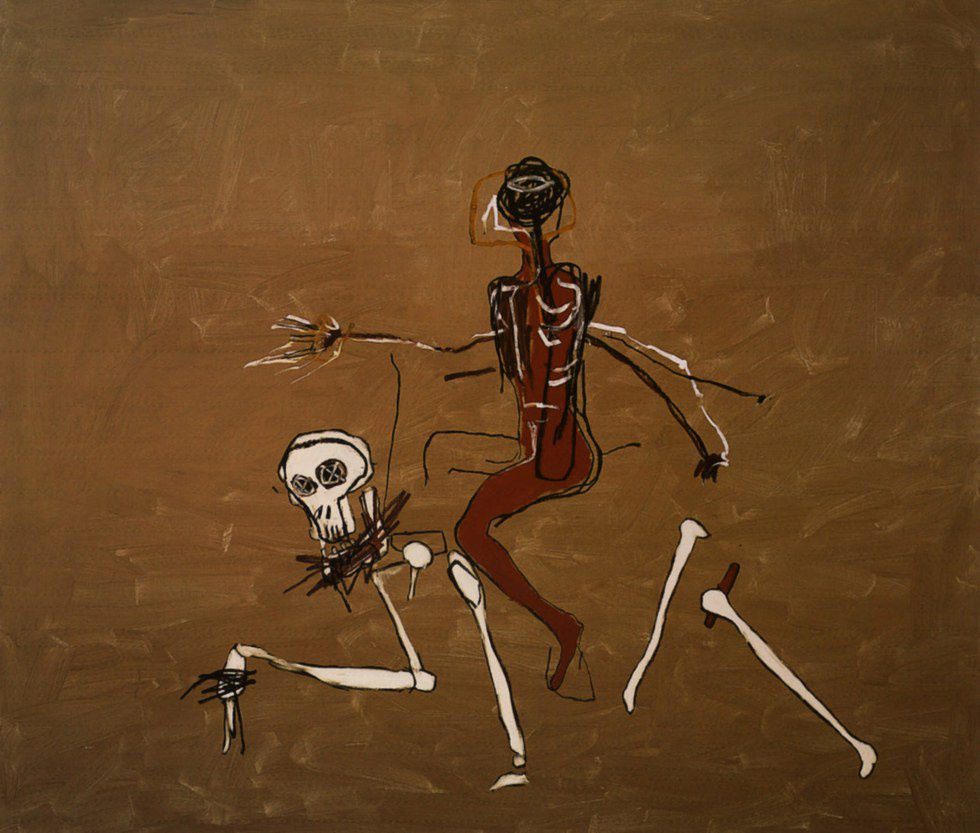When the general public thinks of art, artists such as Vincent Van Gogh, Pablo Picasso, and Jackson Pollock are just a few that come to mind. However, there is one artist that many are unaware of: Jean-Michel Basquiat. Basquiat was one of the first African Americans to have his art internationally recognized and also played a huge role in the Pop Art movement during the 1970’s and 1980’s with close friend, Andy Warhol. Basquiat was heavily impacted by the African American community, and in return created beautiful forms of self-expression to portray his community. In his short life, Basquiat’s art changed the art movements of his time and made an infinite impact on the community.
Jean-Michel Baquiat was born on December 22, 1960 in Brooklyn, New York. At a very young age, Basquiat’s parents noticed that their son was extremely interested in drawing. His mother, Matilda, was also artistic and pushed her son to continue working on his art; often, she would take him to local art museums to encourage him to work hard in school and achieve his artistic goals. Because of her support, Basquiat said, “I’d say my mother gave me all the primary things. The art came from her” (Basquiat, “The Artist”). His mother’s support gave Basquiat the foundation that he needed to follow his passion for art. Basquiat’s father, Gerard, was also incredibly impressed with his son’s work, and promoted his passion like Matilda did. Gerard, shocked by his son’s talent, said that “he was always so bright, absolutely an unreliable mind…he drew and painted all his life from the time he was three or four years old” (Gerard Basquiat, “The Artist”). With this type of support system, Basquiat had some of the most essential tools he needed to succeed. He had a great support system from his family and was always encouraged to continue working on his art. But this did not last forever.
Basquiat standing beside his graffiti
When he was seven years old, Basquiat’s parents separated and he, with his two sisters, went to live with his father. After the separation, Basquiat began to give his father a lot of trouble, and at age fifteen, he dropped out of school and ran away from home, staying in Washington Square Park for about two weeks until his father found him and brought him home. During this time in the park, Basquiat developed a drug problem, “I just sat there dropping acid…Now that all seems boring; it eats your mind up” (Basquiat, “The Artist”). It started with acid, and from there, he soon became addicted to heroin. After returning to school, Basquiat and his friend, Al Diaz, began to graffiti subway cars with the tag “SAMO,” meaning “Same Old S**T.” This marked the beginning of Basquiat’s fame. He left this tag everywhere and quickly became known as “SAMO” throughout the city. “They began spray-painting aphorisms on the D train of the IND line and around lower Manhattan. The writings consist of witty philosophical poems: SAMO as an end to mindwash religion nowhere politics, and bogus philosophy,’ ‘SAMO saves idiots, Plush safe he think; SAMO” (basquiat.com/artist). Basquiat and Diaz used this form of expression to share their opinions with the world and to release any anger they had bottled up. Ultimately, this is what kick-started Basquiat’s artistic career.
As an African American, Basquiat struggled to get recognition. However, he never let that slow him down. Often, Basquiat would use his race to influence his work. Critiques say that, “Basquiat’s work was ride with imagery commenting on race relations in America, and drawing from the culture of the African Diaspora” (artnet.com). Because this was the base for much of his work, his paintings became very appealing to the public. At the start of his career, Basquiat met one of the most influential artists of the time, Andy Warhol, and they became fast friends. Warhol was known for leading the “Pop Art” movement, and helped Basquiat start his own type of art movement. As Basquiat gained fame, “His rise coincided with the emergence of a new art movement, Neo-Expressionism” (biography.com). This truly helped Basquiat find his place in the art community, and it was with the help of Warhol. Together, Basquiat and Warhol exhibited their work nationwide, and eventually, Warhol helped Basquiat gain international recognition and thrusted him into the spotlight.
"Dustheads"
What made Basquiat so unique and successful was his style of simplicity and abstractness. Many of his paintings appeared to be childish scribbles, but at second glance, his work was actually more than met the eye. His paintings displayed his feelings, his struggles, his loves, and any other ideas that came to mind. Basquiat would even create some of his pieces on random items he found on the street, like refrigerators, doors, tires, and boxes. Robert Del Naja, an artist who had the pleasure of knowing Basquiat, said that “He made the possibilities seem limitless. His style was not something you could copy” (theguardian.com). Basquiat has incredible amount of originality, and much like his friend, Warhol, did not care what others thought of his work; his work simply could not be replicated. In several of his works, he incorporated a three-pronged crown, which quickly became a symbol of recognition. This sense of uniqueness gave put him in high standing and is what made more and more people grow interested in his art. But unfortunately, with fame comes fortune, and with fortune can sometimes come addiction.
Andy Warhol and Jean-Michel Basquiat exhibition poster
When Basquiat started showing his work internationally, he began to make millions; with all of that extra cash that he never had before in his life, he thought he could spend it on drugs. Basquiat quickly became addicted to cocaine and heroin and openly admitted to his drug abuse, “I had some money; I made the best paintings ever. I was completely reclusive, worked a lot, took a lot of drugs. I was awful to people” (Basquiat, “The Artist”). Sadly, instead of investing his money, he spent too much of it on drugs, mainly because he had never had this much money before and saw these drugs as a delicacy, and therefore thought it was okay to treat others poorly. In 1984, Basquiat’s drug use escalated to a point where his friends became greatly concerned and feared for his career. He began showing up to his exhibits appearing sloppy and under the influence, and was often rude to those interested in purchasing his pieces. According to an article in the New York Times, Basquiat “gained notoriety for once dumping a bowl of fruit and nuts on a dealer's head, and destroying a series of paintings that another dealer, Ms. Nosei, had wished to sell” (Jean Michel Basquiat: Hazards Of Sudden Success and Fame). His problem was spinning wildly out of control as he was becoming more disruptive, and his career was beginning to take a turn. At one point, Basquiat fled to Hawaii for a little while, attempting to fix his addiction. Upon his return, he was only slightly better, but things truly took a turn for him when his good friend, Andy Warhol, passed away in February 1987.
"Trumpets"
After Andy’s passing, Basquiat became extremely depressed. His feelings of sadness began to show in his work, and many of his pieces depicted this sadness, but also darkness and death. Donald Rubell, someone close to both Warhol and Basquiat, saw Basquiat taking a turn for the worst and knew that things would not end well for Basquiat after Warhol’s death:
The death of Warhol made the death of Basquiat inevitable, somehow Warhol was the one person that always seemed to be able to bring Jean-Michel back from the edge. Always when Jean-Michel was in the most trouble it seemed that Andy Warhol was the person who he would approach… After Andy was gone there was no one that Jean-Michel was in such awe of that he would respond to (Donald Rubell, “The Artist”).
Just like Rubell anticipated, Basquiat died of a heroin overdose on August 12, 1988 at age twenty seven. Basquiat found it a bigger struggle each day that passed, and eventually, he just could not live without Andy anymore, and found no reason to continue living at all; he had slipped through the cracks too quickly for anyone to try and help him before it was too late.
"Riding with Death"
Even though he died at a young age, and his career was not as long as most, Basquiat made a massive impact on the art community and he accomplished so much in such a short period of time. Basquiat’s legacy still lives on through the art he left behind. Many of his pieces sell for a few hundred thousand, while others are on display in museums, like the MoMA, and galleries across the globe. Jean-Michel Basquiat will forever be known for his simple, abstract, and unique work that revolutionized art in the 1970s and 1980s. He will forever be renowned as one of the first African American’s to gain international recognition for his work. Basquiat is also memorialized in film format; “Basquiat” is a movie based on his life, and “Jean-Michel Basquiat: The Radiant Child” is a documentary released by PBS containing exclusive interviews with Basquiat and many of his close friends, while also highlighting his life and successful career. His death might have been tragic, but his life was incredible.
Works Cited
Del Naja, Robert. "Jean-Michel Basquiat: The Street-Art Inspiration for Massive Attack."The Guardian. 14 Oct. 2013. Web. 14 Jan. 2015.
"Jean-Michel Basquiat (American, 1960–1988)."Jean-Michel Basquiat Biography – Jean- Michel Basquiat on Artnet. Web. 14 Jan. 2015.
"Jean-Michel Basquiat."Bio.com. A&E Networks Television. Web. 14 Jan. 2015.
"The Artist."The Artist. Web. 14 Jan. 2015.
Wines, Michael. "Jean Michel Basquiat: Hazards Of Sudden Success and Fame."The New York Times. The New York Times, 26 Aug. 1988. Web. 14 Jan. 2015.




